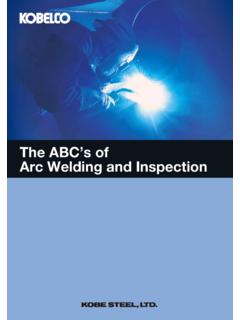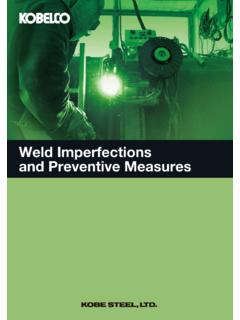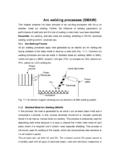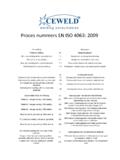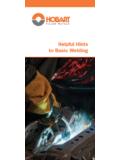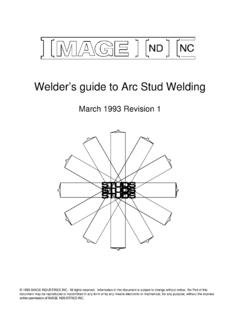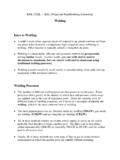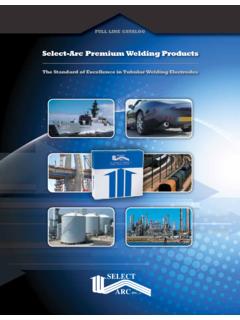Transcription of Arc Welding of Nonferrous Metals
1 Arc Welding ofNonferrous MetalsArc Welding ofNonferrous Metals Published by KOBE STEEL, LTD. 2015 by KOBE STEEL, LTD. 5-912, Kita-Shinagawa, Shinagawa-Ku, To k y o, 141-8688 Japan All rights reserved. No part of this book may be reproduced, in any form or by any means, without permission in writing from the publisher The Arc Welding of Nonferrous Metals is a textbook for providing information to assist Welding personnel study the arc Welding technologies commonly applied in the equipment made from aluminum, aluminum alloys, copper, copper alloys, nickel, and nickel alloys. Reasonable care is taken in the compilation and publication of this textbook to insure authenticity of the contents. No representation or warranty is made as to the accuracy or reliability of this information.
2 Iii Forewords Nonferrous Metals are non-iron-based Metals such as aluminum and aluminum alloys, copper and copper alloys, nickel and nickel alloys, titanium and titanium alloys, and magnesium and magnesium alloys. Today, Nonferrous Metals are used in various Welding constructions for diverse industrial applications. However, their weldability is quite different from that of steel, due to specific physical and metallurgical characteristics. Therefore, the Welding procedure for Nonferrous Metals should be thoroughly examined taking into account the inherent characteristics of the particular Nonferrous metal to be welded, in order to get sound weldments. This textbook focuses on the arc Welding of aluminum, aluminum alloys, copper, copper alloys, nickel, and nickel alloys that are used more extensively over other Nonferrous Metals for industrial applications.
3 This textbook consists of three chapters: Chapter 1: Arc Welding of Aluminum and Aluminum Alloys Chapter 2: Arc Welding of Copper and Copper Alloys Chapter 3: Arc Welding of Nickel and Nickel Alloys Chapter 1 Contents Introduction 2 General characteristics 3 Wrought products 5 Nonheat-treatable type 6 Heat-treatable type 6 Chemical and mechanical properties 7 Casting products 10 Weldability of aluminum and aluminum alloys 11 Filler metal selection 14 Gas tungsten arc Welding 16 Gas metal arc Welding 19 Welding groove preparation
4 21 Welding conditions 24 Welding distortion and countermeasures 26 Weld discontinuities and preventive measures 29 1. Types and features of aluminum and aluminum alloys 3 2. Weldability and filler metal selection 11 3. Welding processes and procedures 16 Arc Welding of Aluminum and Aluminum Alloys Arc Welding of Aluminum and Aluminum Alloys 2 Introduction Nowadays, aluminum and aluminum alloys are extensively used for various applications such as household utensils, autos, railroad cars, buildings, bridges, aircrafts, spacecrafts, ships, chemical equipment, water gates, and storage tanks, because of the inherent advantages of high strength-to-weight ratio, high notch toughness at cryogenic temperatures, excellent corrosion resistance, ease in extrusion, and good fabricability.
5 Aluminum and its alloys are readily joined with most of the known joining processes including Welding , brazing, soldering, adhesive bonding, and mechanical fastening. Of these joining processes, Welding is most widely used. The Welding processes used for aluminum and its alloy assemblies are arc Welding , stud Welding , electron beam Welding , laser beam Welding , resistance Welding , solid-state Welding , and oxyfuel gas Welding . Of these Welding processes, arc Welding is most extensively used. The arc Welding processes used commonly in the assemblies are gas tungsten arc Welding (GTAW) and gas shielded metal arc Welding with solid wires (refer to as GMAW hereinafter). Basically, aluminum and its alloys can successfully be arc welded by using conventional G TAW/G M AW equipment and techniques used for other Metals , provided the Welding procedure is suitable.
6 However, occasionally specialized equipment or techniques, or both, are required due to the inherent unique physical and mechanical characteristics of aluminum and its alloys. This section focuses on G TAW and GM AW of aluminum and its alloys and discusses diverse types of such Metals and their weldability, suitable Welding equipment, proper filler Metals and Welding procedures, and provides tips for sound welds. References [1] The Japan Light Metal- Welding and Construction Association, Introductory Course for Inert Gas Arc Welding of Aluminum (Alloys), 2001 [2] The American Welding Society, Welding Handbook, 8th Edition, Vol. 3, 1996 [3] A. Kamio, The New Era of Aluminum, 1999, Kogyo Chosakai Publishing Co., Ltd. [4] Kobe Steel, Ltd., Welding Electrodes Handbook, 1964 [5] The Japan Welding Engineering Society, Seminar Textbook for ISO 14731/WES 8103 Welding Coordination Personnel Certification Renewal, 2002 [6] M.
7 Mizuno, et. al., Welding of Aluminum and Aluminum Alloys, Sanpo Publications Inc., 1979 [7] Shinko Welding Service Co., Ltd., Exposition of Welding Terms, 1999 [8] T. Tachibana, Materials and Procedures for Aluminum MIG Welding , Journal of the Japan Welding Society, Vol. 70, No. 3, 2001 [9] The American Welding Society, Welding Handbook, 8th Edition, Vol. 2, 1991 [10] Kobe Steel, Ltd., Technical Guide, No. 344, 1998 Arc Welding of Aluminum and Aluminum Alloys 3 1. Types and features of aluminum and aluminum alloys Aluminum and aluminum alloys are the lightest commercial Metals in use in large quantities. Aluminum is easy to extrude and fabricate and has excellent corrosion resistibility. Various types of aluminum alloys are also available in response to demands for higher strength and superior corrosion resistibility for specific applications.
8 This chapter discusses general characteristics, types and features of aluminum and its alloys. General characteristics The applications of aluminum and its alloys are expanding in various industrial fields because of its many advantages over other Metals . The following paragraphs discuss the advantages of aluminum and its alloys for structural material. Table shows a comparison of physical properties between aluminum and mild steel. (1) Lightweight: As shown in Table , the density of aluminum is , which is about 1/3 of that of mild steel ( ). This feature is one of the reasons why aluminum and its alloys are widely used for transportation vehicles such as autos, railway cars (Photo ), aircrafts, and ships (Photo ). By decreasing the weight of the transportation vehicles the energy consumption efficiency can be improved.
9 Photo Shinkansen high-speed trains uses plates, extrusions, castings and forgings of aluminum alloy (Source: Kobe Steel s brochure) Photo A fishing boat made of aluminum alloy structural components. (Source: Kobe Steel s brochure) Arc Welding of Aluminum and Aluminum Alloys 4 (2) Strong: The tensile strength of aluminum is much lower than that of mild steel; however, it can readily be strengthened by alloying with other elements such as copper, manganese, silicon, magnesium, and zinc. Aluminum and its alloys can further be strengthened by cold working (rolling, extrusion, drawing and forging), due to work hardening or strain hardening. The certain group of aluminum alloys can be strengthened by precipitation hardening heat treatment.
10 With this heat treatment, the tensile strength of some alloys becomes comparable to or even higher than that of mild steel. With lower specific gravity, the ratio of strength to specific gravity of many aluminum alloys is higher than that of mild steel. This advantage is useful particularly for transportation vehicles such as aircraft, spacecraft, autos, railroad cars, and boats. (3) High resistance to corrosion: Aluminum forms an oxide film (alumina) on its surfaces in the air. This oxide film is thin but dense enough to protect the base metal in corrosive atmospheres and solutions. In addition, alloying with magnesium provide aluminum with much higher resistance to corrosion. This is why aluminum alloys are extensively used in buildings, ships, and autos.

